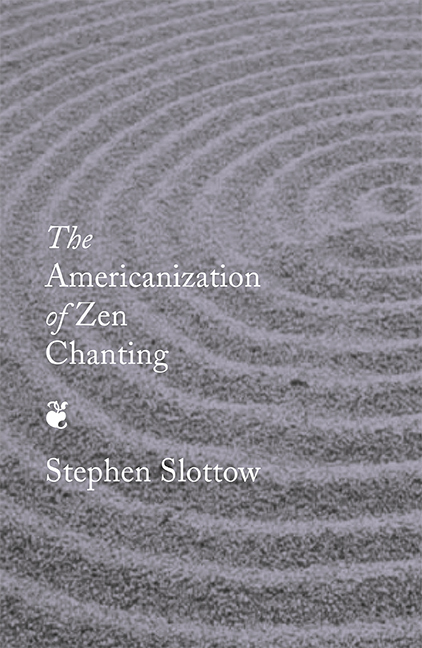Book contents
- Frontmatter
- Contents
- List of Examples
- Acknowledgements
- Chapter 1 Introduction
- Chapter 2 Purposes and Functions of Zen Chanting
- Chapter 3 Performance Practice
- Chapter 4 Typology, Translation, and Ceremonies
- Chapter 5 Conclusion
- Bibliography
- Discography and Videography
- Appendix: Alternative Chant Names
- Index
Chapter 4 - Typology, Translation, and Ceremonies
- Frontmatter
- Contents
- List of Examples
- Acknowledgements
- Chapter 1 Introduction
- Chapter 2 Purposes and Functions of Zen Chanting
- Chapter 3 Performance Practice
- Chapter 4 Typology, Translation, and Ceremonies
- Chapter 5 Conclusion
- Bibliography
- Discography and Videography
- Appendix: Alternative Chant Names
- Index
Summary
Chant Types
There are different ways to classify Zen chants. Of course, any typology automatically creates ambiguities or uncertainties with regard to the assignment of particular chants, but definite types do exist, and it can be useful to recognize them. In the table of contents for Tanahashi 2015 (vii-viii), chants are arranged as follows: daily chants, chants for events, enlightenment poems, and prose chants for study. T. Griffith Foulk categorizes chants by genre: sutras, dharanis, treatises, ekos, and verses. Foulk's field of study is Soto ritual, but his categories apply equally well to Rinzai chants (Bielefeldt and Foulk 2001, 153- 58). In the following short discussion I will rely mainly on Foulk's classification, except that I have added mantras, and prefer the terms “reading” to “treatise,” and “gatha” to “verse.”
Sutras
Strictly speaking, sutras are records of teachings considered to have been spoken by Shakyamuni Buddha. Those used in Zen are mainly Mahayana sutras. As Ruben Habito points out below, “sutra” is also often used as a general term for all Zen or Buddhist chanting. Habito writes:
“Sūtra” is a Sanskrit word that means “thread”—little snippets of sayings of the Buddha that were considered gems of wisdom, so they were taken as “threads of wisdom.”1 The earlier ones were in short easily recitable or memorizable sentences, handed down from generation to generation orally. Later on these were expanded in length. They were later written down (script=scriptures) when writing became a cultural form of expression a couple of centuries or more after the Buddha's lifetime. Derived from this is the current usage of “Buddhist scriptural texts for recitation/chanting” (Ruben Habito, email, September 3, 2018).
Foulk writes that in Japan “they are written and recited in classical Chinese, albeit using Japanese phonetics, which means that the chanting is incomprehensible to the average listener” (Bielefeldt and Foulk 2001, 153). That is, they are in Sino-Japanese with katakana or hiragana transliteration next to the Chinese characters. Kaoru Nonomura corraborates Foulk's point when recounting his first days as a novice monk at Eiheiji:
The sutra books we’d brought with us had phonetic marks to indicate the pronunciation, but the sounds we were hearing for the first time were so unfamiliar that even with a crib sheet to follow, it took considerable practice before any of us could articulate them smoothly (Nonumura 2016, 72).
- Type
- Chapter
- Information
- The Americanization of Zen Chanting , pp. 91 - 132Publisher: Boydell & BrewerPrint publication year: 2018

